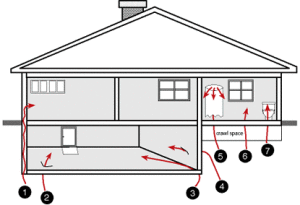What is Radon?
Radon comes from the natural breakdown of uranium in soil, rock and water.
The release of this radioactive gas enters the air you breathe, causing a potential health risk to you and your family.
Radon gas can be found in just about anywhere. It can get into any type of building — homes, offices, and schools — and build up to high levels.
How Does Radon Enter the Home?
Typically the air pressure inside your home is lower than the pressure in the soil around your home’s foundation.
Due to this difference, your house acts like a vacuum, drawing radon gas in through foundation cracks and other openings of your home.
Radon may also be present in well water and can be released into the air in your home when water is used for showering and other household uses.
What are the Risk Factors?
The EPA, Surgeon General and The Center for Disease Control, have all agreed that continued exposure to Radon gas can cause lung cancer.
In fact, there position on the matter is that all homes should be tested for radon gas exposure, and all homes testing over 4 pCi/L should be fixed.

Potential Entry Points:
- 1. Cavities inside walls
- 2. Cracks in solid floors
- 3. Construction joints
- 4. Cracks in walls
- 5. The water supply
- 6. Gaps in suspended floors
- 7. Gaps around service pipes



